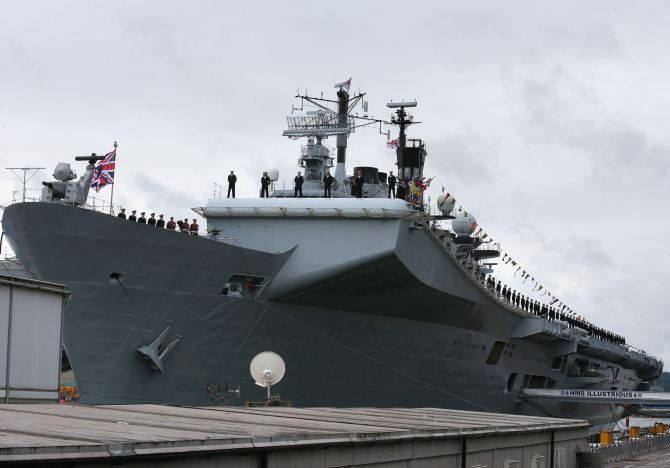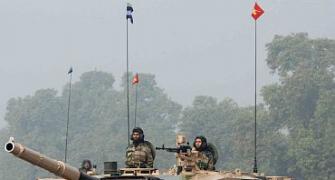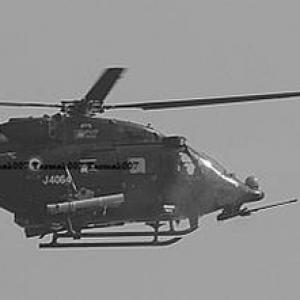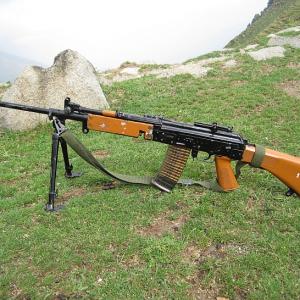
For the first time, the size and specifications of the Indian Navy’s future aircraft carrier have been officially acknowledged. The navy has written to at least four major global shipbuilders, asking for proposals to help in designing a 65,000 tonne carrier that would be about 300 metres long.
The letter of request, issued by the Indian Navy on Wednesday, specifies the carrier should be capable of speeds greater than 30 knots (56 km per hour). However, it is silent on whether it prefers nuclear propulsion, or conventional diesel or gas turbines.
The navy’s letter states the carrier will embark 30-35 fixed wing combat aircraft, and about 20 rotary wing aircraft (helicopters). It would have a catapult to launch fixed wing aircraft, which would make the carrier a “catapult launched but arrested landing”, or CATOBAR vessel. For India’s naval aviators, this would involve a major change from a long tradition of getting airborne from a “ski-jump” at the end of the flight deck.
While not mandating an “electromagnetic aircraft launch systems”, the navy has specifically mentioned it as an option. The United States Navy’s latest carrier, the 100,000-tonne USS Gerald R Ford, which will be commissioned next year, is the world’s only current carrier featuring EMALS. This uses an electromagnetic rail gun to accelerate aircraft to take-off velocity, instead of the conventional steam-driven catapults that have been used for 60 years.
The navy’s letter has gone out to US company, Lockheed Martin; UK company, BAE Systems, French shipbuilder, DCNS, and Rosoboronexport, the Russian export umbrella agency.
The letter pertains to the vessel that is commonly referred to as the “indigenous aircraft carrier number 2”, or IAC-2. Currently, Cochin Shipyard Ltd (CSL) is building IAC-1, a 40,000-tonne carrier named INS Vikrant, which is scheduled to be commissioned in 2018.
INS Viraat will supplement INS Vikramaditya, the 45,000-tonne carrier bought from Russia, which was formerly named the Gorshkov. Another, older carrier, INS Viraat, is expected to be retired by the end of this decade.
For years, the biggest guessing game around the Indian Navy’s future force has been: Will IAC-2 be a massive, EMALS-equipped, nuclear-powered super carrier, developed in partnership with America? So far, admirals have been close-mouthed, saying the process of formulating specifications is underway.
Now, the guessing game is already shifting to: Which shipbuilder does the navy’s specification favour? The US remains the leading horse, not just because it is the world’s most experienced and technologically advanced carrier operator with more aircraft carriers in service than the rest of the world combined.
There is also a US-India “working group”, constituted during US President Barack Obama’s visit to India in January, specifically to promote cooperation in aircraft carrier technology. New Delhi and Washington are known to have discussed EMALS under the rubric of the Defence Trade and Technology Initiative.
Yet, there could be others in the race. Vendors point out that the specifications framed bear similarities to the French aircraft carrier, Charles de Gaulle (in terms of speed and size, though not in displacement), and the British Queen Elizabeth II (in terms of displacement and size, though not in speed).
Surprisingly, the navy’s letter allows the foreign vendors just one week to respond, demanding a reply by July 22. The reply is required to contain costing elements along with the proposal.
“This involves evaluating a consultative, hand-holding process that will last at least a decade. There is no way anyone can produce a detailed cost proposal in such a short time,” complains a senior executive with one of the foreign vendors.
Experts have begun evaluating the implications of the navy’s specifications. It is pointed out that asking for 25-30 fighters and 20 helicopters on a 65,000 tonne, 300-metre-long carrier would limit the size of the aircraft on the ship. If heavy fighters are to be a part of the ship’s complement, it would need to be bigger; if the MiG-29K is retained, it would need a foldable nose to occupy less hangar space.
It is also pointed out that specifying a speed in excess of 30 knots eliminates certain forms of propulsion, notably an all-electric drive, which is environment friendly and economical.











